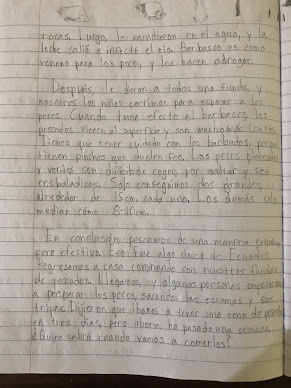¡A Pescar!
The people of this region are river people. They live banked by rivers. They are expert river crossers -- leaping across stones and/or haphazardly placed bamboo planks -- and experienced river readers. They know the history of their rivers, of the bridges that have been built and swept away, of the times the river grew so big that trapped folks for days. And while the town is technically located in Cotopaxi Province, we are quite literally on the border of Los Rios Province (The Rivers Province).
Last week, as families gathered for Finados, our Ecuadorian family got a bee in their collective bonnet with an urge to fish the little river that crosses through their land. They said it had been years; for me, it had been decades. For Paul and the kids, it was their very first time fishing in Ecuador. Mind you, this is not your typical fishing rod, beer, and bait sort of adventure. Fishing the rivers here involves native plant venom, rubber boots, river restructuring, and literally all hands in the water.
After a hearty birthday lunch of chicken soup and rice, we were instructed by the matriarch, Señora Inez, 74 years young, to quietly change our clothes, put on long sleeves and boots, and meet back at her house in fifteen minutes, at which time, a crew of 25 or so were to head to the river to prepare the waterway for a group fishing event. ¡A pescar!
I'll let Dillon fill in the details of the fishing adventure. What you see below is a photo of Dillon's Spanish escritura (essay), which he wrote for school this week. The English translation of his essay follows.
________
Uniquely Fishing in La Josefina
by Dillon Poling (age 12)
This past weekend my family and many of our friends went fishing in a nearby river. We had to reroute the river, use venom from a root, and wet our shoes. All of this was to fish with our hands and catch dozens of little fish. It was super fun, and I caught a ton of fish, even though I did get pinched by a catfish spine.
First, we walked until we arrived at a part of the river where a small stream separated from the larger river. Everyone worked together to take out rocks and open up space for the stream to grow. When it was all ready, the adults used large sheets of plastic to reroute even more water. Now the larger river contained less water and less current. It was time for the next step.
If you are wondering how we are going to catch fish with our hands, now I am going to tell you. Earlier that day, some people had gone to Mirian's farm to dig up some roots called barbasco*. Before we started fishing, the adults took the barbasco and ground it up with rocks. Then they shook the roots into the water and a milky substance drained into the river. Barbasco is like a poison for the fish, and it makes them woozy.
After, everyone was given a plastic bag and all the children ran to wait for the fish. Once the barbasco took effect, the fish started rising to the surface, and were much slower. You have to be very careful with the catfish because they have spines that hurt a lot. The silver and green fish are hard to catch because they jump and are very slippery. We only caught two big fish, around 15 cm each. The rest were all very small, around 8-10 cm in length.
In conclusion, we fished in a strange but effective method. This was an Ecuador-only experience. We returned to the house, walking with our plastic bags of fish. When we arrived, some people started preparing the fish, taking off the scales and removing their guts. They said that we were going to have a fish dinner in three days, but now it has been a week. Who knows when we are going to eat them all?
________
*As Dillon writes above, early that morning, two young women harvested the roots of a substance called barbasco from their finca up in the hills above La Josefina. Barbasco is the common name for several different tropical plants that contain poisonous chemical compounds used by indigenous people of the Americas to poison and then harvest fish. The venomous resin is usually extracted from the roots of the plant, though it is also present in the leaves of some varieties. Barbasco causes respiratory depression and paralysis in fish of all sizes. Some varieties have been studied by pharmaceutical companies. There is concern in Ecuador about barbasco's environmental impact as well as controversy about the safety and legality of its use in streams and rivers. Despite it being a native plant, its impact on the fish is clearly deleterious, and it is not a leap to assume that ongoing and widespread use could have long-standing negative impacts on the larger ecosystem. Of note, locals commonly describe how the fish population in local streams and rivers has been markedly depleted over the last few decades.





























Is the 3 day wait to allow it to get out of the fish's system?
ReplyDelete